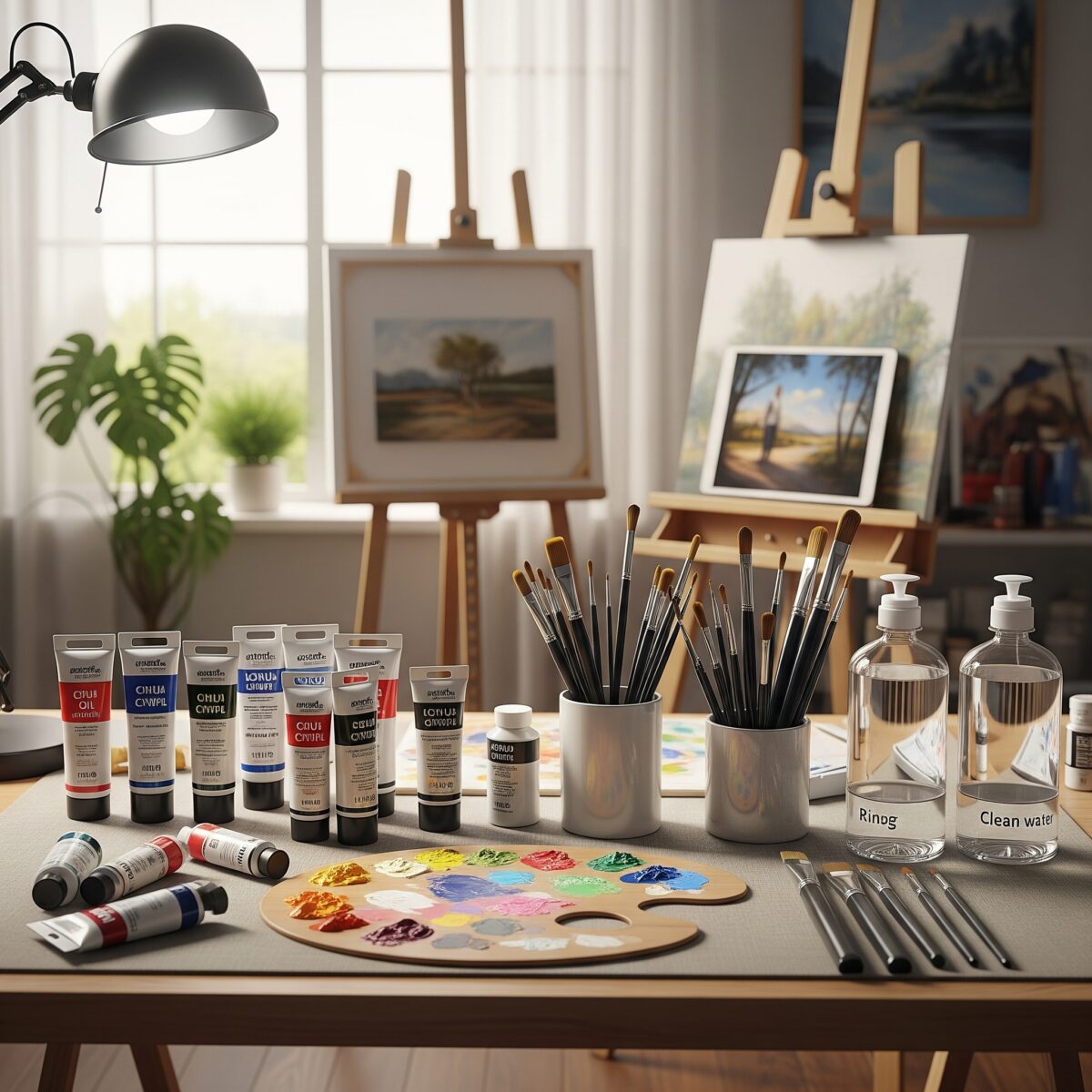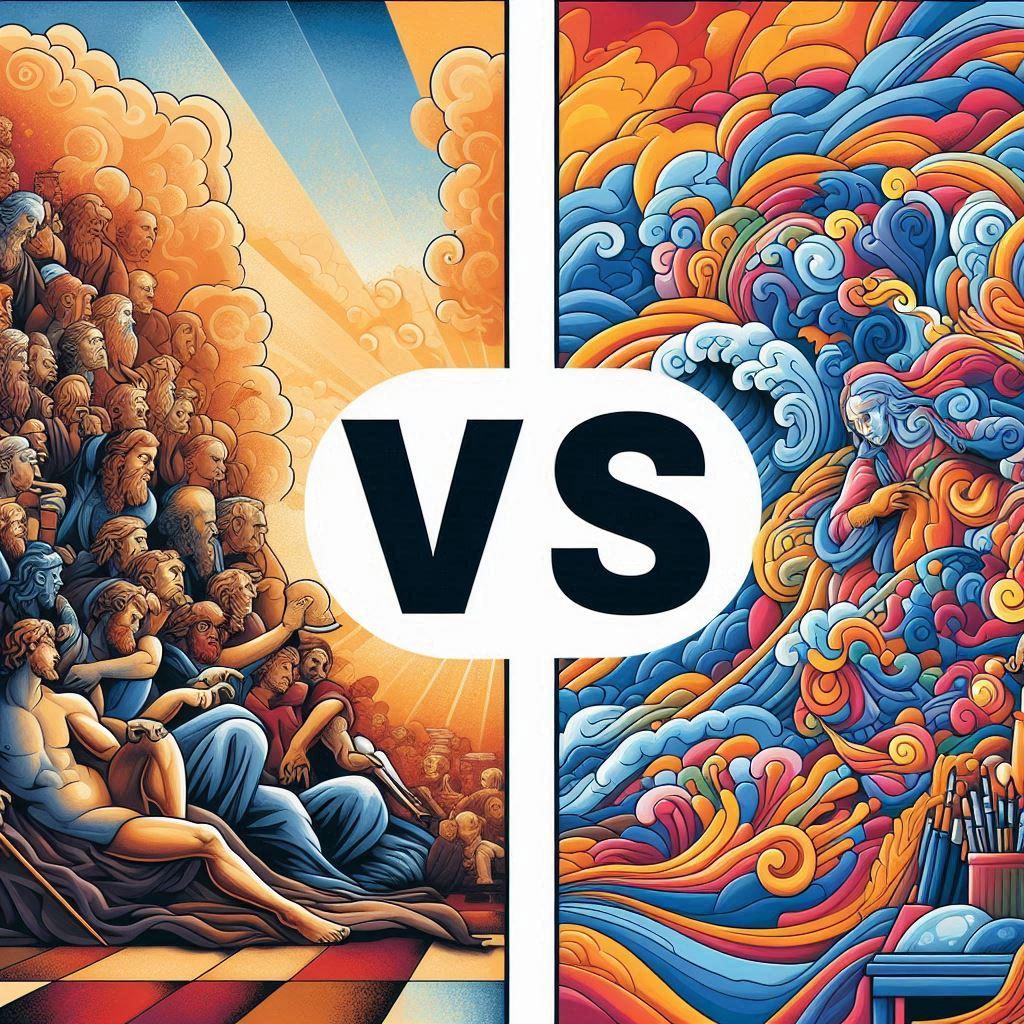As artists, we constantly strive for that perfect balance between speed and precision. We dream of translating our vision onto canvas with fluid strokes and vibrant colors, all while meeting deadlines and maintaining the integrity of our work. But the reality of the painting process often involves frustrating delays, meticulous layering, and the nagging feeling that we could be more efficient. The good news is, mastering how to paint faster without compromising quality is entirely achievable. It’s not about rushing; it’s about optimizing your process, developing smart habits, and understanding the materials you use.
This comprehensive guide will delve into actionable strategies that will transform your painting workflow. We’ll explore techniques for efficient setup, smart material choices, effective brushwork, and mindful decision-making that will allow you to create beautiful art at a more productive pace. Get ready to unlock your artistic potential and discover how to paint faster while elevating your artistry.
“The artist who has trained his eye and hand, and whose mind is clear, can paint a masterpiece with the same economy of effort that a skilled craftsman uses to carve a simple piece of wood.”
Key Point Summary:
- Preparation is Paramount: A well-organized studio and readily accessible materials significantly reduce downtime.
- Strategic Material Selection: Choosing the right paint types, mediums, and brushes can dramatically speed up drying times and application.
- Brushwork Efficiency: Mastering different brushstrokes and employing strategic layering techniques saves time and enhances visual depth.
- Compositional Planning: A clear understanding of your subject and composition minimizes indecision and rework.
- Mindful Decision-Making: Knowing when to push forward and when to refine prevents wasted effort.
- Embrace the Digital: Digital sketching and color studies can accelerate the planning phase.
- Practice and Experimentation: Consistent practice and exploring new techniques are crucial for improving speed and quality.
Setting the Stage for Speed: The Art of Preparation
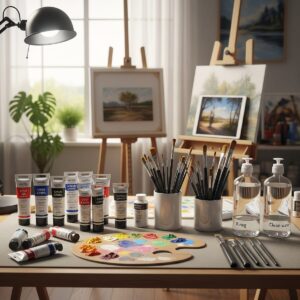
The foundation of painting faster lies in meticulous preparation. Think of your studio as a well-oiled machine, where every tool and material is in its rightful place, ready for action. This proactive approach eliminates the frustrating search for a specific brush or the realization that you’re missing a crucial color.
1. Organize Your Workspace:
- Designated Zones: Create distinct areas for mixing colors, staging your palette, and keeping your brushes. A clean, uncluttered workspace is a clear mind’s best friend.
- Accessible Supplies: Keep your most frequently used brushes, paints, and mediums within easy reach. Consider a tiered brush holder or a dedicated drawer for brushes.
- Palette Management: Have multiple palettes ready, perhaps one for warm tones, one for cool tones, or even pre-mixed foundational colors if you work with a consistent palette. This saves precious mixing time.
- Water Containers: Have at least two water containers – one for rinsing brushes and one for a final clean. For oil painters, a solvent container and a rinse container are essential.
- Reference Material Setup: Ensure your reference images are clearly visible and well-lit. If working from life, position your subject and lighting optimally before you begin.
2. Efficient Palette Setup:
- Pre-Mixing Essentials: For certain subjects or styles, pre-mixing common tones like flesh tones, greens, or grays can be a significant time-saver.
- Strategic Color Placement: Arrange your colors on the palette in a logical order, perhaps following a color wheel or grouping similar hues. This aids in quick color recall and mixing.
- Limit Your Palette (Initially): While a vast palette offers creative freedom, starting with a limited palette can simplify mixing and ensure color harmony, ultimately leading to faster decisions.
Material Magic: Choosing the Right Tools for Speed
The materials you choose have a profound impact on your painting speed and the quality of your finish. Understanding the properties of different paints, mediums, and brushes can unlock new levels of efficiency.
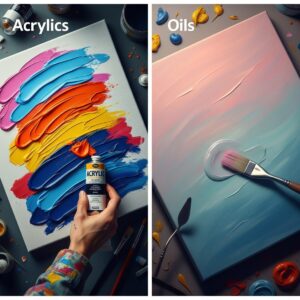
1. Paint Selection: The Drying Dilemma
- Acrylics: The Speedy Choice: Acrylic paints are renowned for their fast drying times. This can be a double-edged sword. While it allows for rapid layering and building up of textures, it also requires quick application and can be unforgiving for blending.
- Tips for Acrylic Speed:
- Retarders: Use acrylic retarders or flow improvers sparingly to extend drying time for blending.
- Damp Cloth: Keep a damp cloth or spray bottle handy to reactivate paint on your palette or canvas.
- Layering: Embrace the quick-drying nature for rapid layering of opaque colors.
- Tips for Acrylic Speed:
- Oils: The Blending Advantage: Oil paints dry much slower, offering ample time for seamless blending and reworking. However, this also means waiting for layers to dry before applying subsequent ones.
- Tips for Oil Speed:
- Alkyd Mediums: These mediums accelerate drying times significantly, allowing for faster layering.
- Lean-to-Fat Principle: Adhering to the “lean-to-fat” rule (using thinner, oil-lean layers first and progressively oil-rich layers on top) ensures proper drying and prevents cracking.
- Impasto Techniques: Thick, buttery applications of paint can dry faster than thin washes.
- Tips for Oil Speed:
- Watercolors: The Flow Factor: Watercolors rely on the controlled flow of pigment and water. Speed here comes from confident washes and efficient color mixing.
- Tips for Watercolor Speed:
- Wet-on-Wet: Embrace wet-on-wet techniques for swift, soft transitions.
- Pre-mixed Washes: Prepare large washes of common colors beforehand.
- Control the Water: Developing a keen sense of how much water to use is crucial for efficient application.
- Tips for Watercolor Speed:
2. Mediums: Your Allies in Efficiency
Mediums are not just for altering paint properties; they are powerful tools for accelerating your workflow.
- Acrylic Mediums: Glazing mediums, gloss mediums, and flow improvers can all contribute to faster application and smoother blending.
- Oil Mediums: Alkyd mediums (like Liquin, Galkyd, Neo Megilp) are game-changers for oil painters seeking faster drying times and improved flow. Linseed oil and stand oil also influence drying time and consistency.
- Watercolor Mediums: Gum arabic can increase transparency and flow, while ox gall can improve wetting and prevent beading.
3. Brushwork Brilliance: The Right Tool for the Job
The brushes you use directly impact the speed and quality of your mark-making.
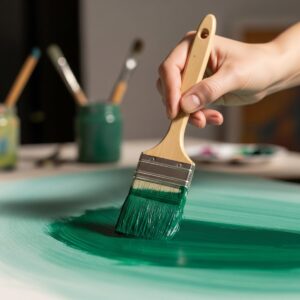
- Brush Types:
- Flat and Bright Brushes: Excellent for covering larger areas quickly and for sharp, defined strokes.
- Filbert Brushes: Versatile for both blending and creating softer edges.
- Round Brushes: Ideal for details and line work, but can be slower for broad strokes.
- Fan Brushes: Useful for blending and creating soft textures, particularly in skies or foliage.
- Brush Size: Don’t shy away from using larger brushes for larger areas. This is a fundamental principle of painting faster. Smaller brushes are for detail, larger brushes are for coverage.
- Brush Care: Clean brushes are essential for efficient painting. Dried paint clogs brushes, making them difficult to use and ultimately slowing you down. Invest in good brush cleaning supplies.
Mastering the Brushstroke: Techniques for Swift Application
Beyond choosing the right tools, the way you handle your brush can dramatically impact your speed and the visual impact of your work.
1. Confident Strokes:
- Economy of Motion: Aim to make each brushstroke count. Think about the direction, pressure, and coverage you want to achieve before you touch the canvas.
- Embrace Gestural Strokes: Especially in the initial stages, use larger, more gestural strokes to lay down the foundation of your painting. This quickly establishes form and value.
- Variety of Strokes: Learn to vary your brushstrokes to create interest and convey different textures. A mix of broad strokes, dabbing, and finer lines can add dynamism.
2. Strategic Layering:
- Alla Prima (Wet-on-Wet): This technique involves completing the painting in one session while the paint is still wet. It’s inherently fast but requires confident application and immediate decision-making.
- Glazing: Applying thin, transparent layers of color over dried underlayers can build depth and luminosity quickly. Acrylic glazing mediums are particularly effective here.
- Scumbling: Applying a thin, broken layer of opaque or semi-opaque paint over a dry underlayer creates texture and softens edges.
3. Efficient Blending:
- Wet-on-Wet Blending: For oils and slower-drying acrylics, blend colors while they are still wet. Use soft brushes or even your fingers (with caution for skin sensitivity) for seamless transitions.
- Dry Brushing: Using a brush with very little paint and moisture to create a broken, textured effect can quickly add highlights or soften edges.
- Using a Clean Brush: For seamless transitions, particularly with oils, use a clean, dry brush to soften edges and blend colors.
The Power of Planning: Composition and Color
Indecision and rework are major time-sinks. A well-thought-out plan before you pick up your brush can save you hours.
1. Thumbnail Sketches and Studies:
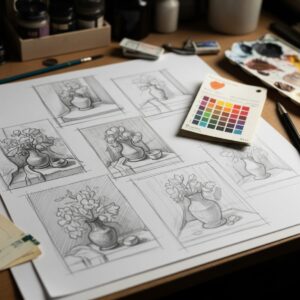
- Compositional Exploration: Before committing to your main canvas, create multiple small thumbnail sketches to explore different compositional arrangements. This helps you identify the strongest layout quickly.
- Color Studies: Create small color studies to test your palette choices and ensure color harmony. This prevents unexpected color clashes and saves you from repainting large areas.
2. Digital Assistance:
- Digital Sketching: Utilize digital art software to create detailed sketches, experiment with compositions, and even do digital color studies. This allows for rapid iteration and easy manipulation of elements.
- Photo Editing: For photographic references, use editing software to adjust contrast, saturation, and color balance. This can simplify the process of translating your reference to paint.
3. Understanding Your Subject:
- Break Down Forms: Before painting, analyze your subject into its basic geometric shapes and planes. This understanding will guide your brushstrokes and make rendering faster.
- Value Studies: Focus on accurately capturing the light and shadow patterns (values) of your subject. A strong value structure is the backbone of a successful painting and can be laid down quickly.
Mindset and Momentum: Maintaining Flow
Your mental approach to painting plays a crucial role in your speed and overall productivity.
1. Embrace Imperfection (Initially):
- The First Layer is Not the Final Layer: Don’t get bogged down in perfectionism from the start. Allow yourself to make bold marks and explore without fear. You can refine later.
- Focus on the Big Picture: Concentrate on establishing the overall form, values, and colors before diving into intricate details.
2. Set Realistic Goals and Time Limits:
- Work in Sessions: Break down your painting process into manageable sessions. This prevents burnout and allows you to maintain focus.
- Time Yourself: Experiment with setting time limits for certain stages of your painting, such as blocking in colors or completing a specific area. This can help you push past procrastination.
3. Learn to Step Back:
- Fresh Perspective: Regularly step back from your work to assess your progress and identify areas that need attention. This allows you to catch mistakes early and avoid wasted effort.
- Mirror Imaging: Looking at your painting in a mirror can reveal compositional imbalances or drawing errors you might otherwise miss.
4. Continuous Learning and Experimentation:
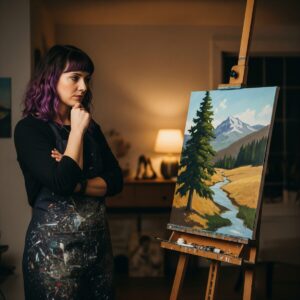
- Watch Demonstrations: Study the techniques of artists you admire. Observing how they handle their brushes and materials can provide valuable insights.
- Experiment with New Tools and Mediums: Don’t be afraid to try different brushes, paint types, or mediums. You might discover new ways to work more efficiently.
- Practice, Practice, Practice: The more you paint, the more intuitive your process will become. Your muscle memory will improve, and you’ll develop a better understanding of how to translate your vision quickly and effectively.
By integrating these strategies into your artistic practice, you’ll find yourself not only painting faster but also with a greater sense of confidence and control. Remember, the goal is not to rush through your art but to streamline your process so that your creative energy flows unimpeded onto the canvas, resulting in stunning artwork created efficiently and with impeccable quality. Mastering how to paint faster is an ongoing journey of refinement and discovery, one that will undoubtedly enrich your artistic life.
| Rank | Artist | Era/Movement | Notes on Speed/Productivity |
|---|---|---|---|
| 1 | Claude Monet | Impressionism | Known for painting en plein air (outdoors) quickly to capture fleeting light and atmospheric conditions. Often produced numerous works in a short period. |
| 2 | Vincent van Gogh | Post-Impressionism | Extremely prolific, especially in his later years. His energetic brushstrokes and rapid application of paint suggest a desire to capture intense emotion and observation quickly. |
| 3 | J.M.W. Turner | Romanticism | His later works often exhibit a remarkable speed and abstraction, capturing the essence of light, atmosphere, and movement with seemingly rapid, broad strokes. |
| 4 | Paul Cézanne | Post-Impressionism | While meticulous, his “constructive stroke” allowed him to build form and color rapidly, and he was incredibly prolific, producing hundreds of works. |
| 5 | Edgar Degas | Impressionism | While known for his meticulous approach to composition, he was also a prolific artist who worked across various mediums and was known for capturing movement swiftly. |
| 6 | Henri Matisse | Fauvism, Modern Art | Known for his bold use of color and line, and particularly his “cut-outs” later in life, which were a faster, more direct way to create compositions. His overall output was immense. |
| 7 | Egon Schiele | Expressionism | His distinctive, energetic line work and frequent self-portraits suggest a rapid capture of form and emotion, with a prolific output of drawings and paintings. |
| 8 | Wassily Kandinsky | Abstract Art | Pioneer of abstract art, known for his prolific output of paintings and theoretical writings. His energetic, vibrant compositions often feel intuitively and rapidly executed. |
| 9 | Georgia O’Keeffe | American Modernism | While carefully composed, her distinctive, bold forms and prolific career spanning decades indicate efficient execution of her unique vision. |
| 10 | Andy Warhol | Pop Art | Celebrated for his “factory” production line approach, using silkscreen printing and assistants to produce art at an unprecedented speed and volume. |
Disclaimer: “Fast painters” is interpreted here as artists known for prolific output, energetic styles, or rapid execution techniques rather than strictly measured painting times. Historical data on precise painting speed is not readily available for most artists.
Frequently Asked Questions about Painting Faster:
Q1: How can I make acrylic paint dry slower so I have more time to blend?
You can use acrylic retarder mediums or flow improvers, which extend the drying time of acrylics, allowing for more seamless blending. Keeping a spray bottle of water handy to mist your canvas or palette can also help reactivate the paint and prolong its workable state.
Q2: What are the best brushes for painting quickly?
Larger brushes are generally better for covering areas faster. Flat and bright brushes are excellent for broad strokes and covering large spaces, while filbert brushes offer versatility for blending and shaping. Don’t be afraid to use the largest brush that the area you’re painting will comfortably accommodate.
Q3: Is it possible to paint faster without compromising the quality of my artwork?
Absolutely! The key is efficient preparation, smart material choices, practiced techniques, and clear planning. It’s about working smarter, not just faster. By optimizing your workflow and understanding your materials, you can achieve both speed and quality.
Q4: How do I avoid making mistakes when I’m trying to paint faster?
Making mistakes is a natural part of the artistic process. However, to minimize them when painting faster, focus on strong preliminary planning, such as thumbnail sketches and color studies. Also, learn to step back regularly and assess your work with a critical eye. It’s also helpful to embrace the idea that many “mistakes” can be corrected or even incorporated into the final piece.
Q5: What are some effective techniques for speeding up the oil painting process?
For oil painters, using alkyd-based mediums can significantly accelerate drying times, allowing for faster layering. Practicing alla prima (wet-on-wet) techniques and adopting a confident, gestural brushstroke approach are also effective. Always adhere to the “lean-to-fat” principle for proper drying.
Q6: How can I improve my color mixing speed?
Pre-mixing common colors, organizing your palette logically, and understanding color relationships will greatly speed up mixing. Practicing color mixing exercises and developing a good sense of your paint’s properties will also contribute to greater efficiency. Limiting your palette can sometimes accelerate mixing decisions.
Q7: Are there any digital tools that can help me paint faster?
Yes, digital tools can be very helpful. Using digital software for sketching, composing, and creating color studies allows for rapid experimentation and iteration before you even touch a physical canvas. You can easily adjust elements, test color palettes, and refine your composition digitally.

